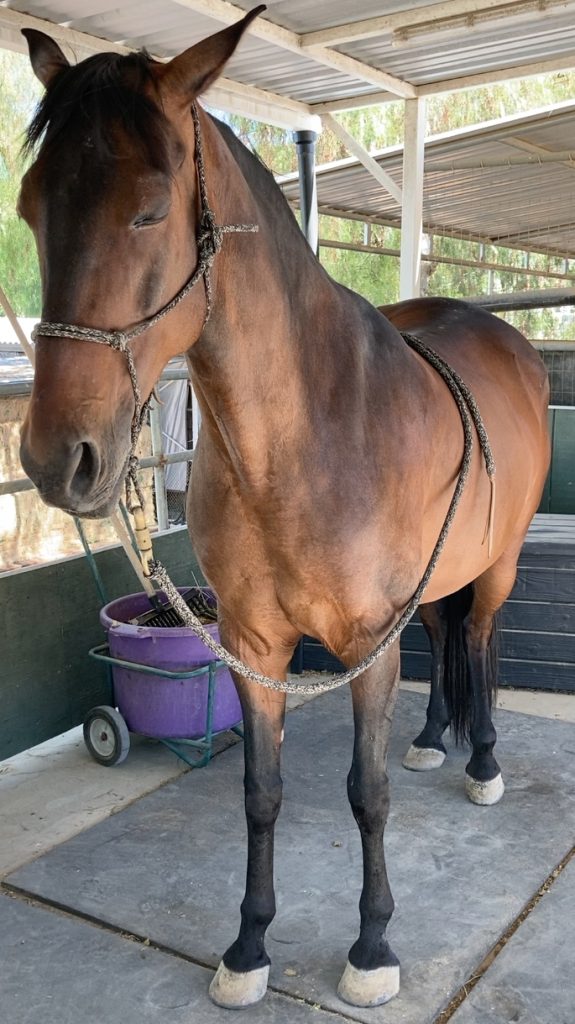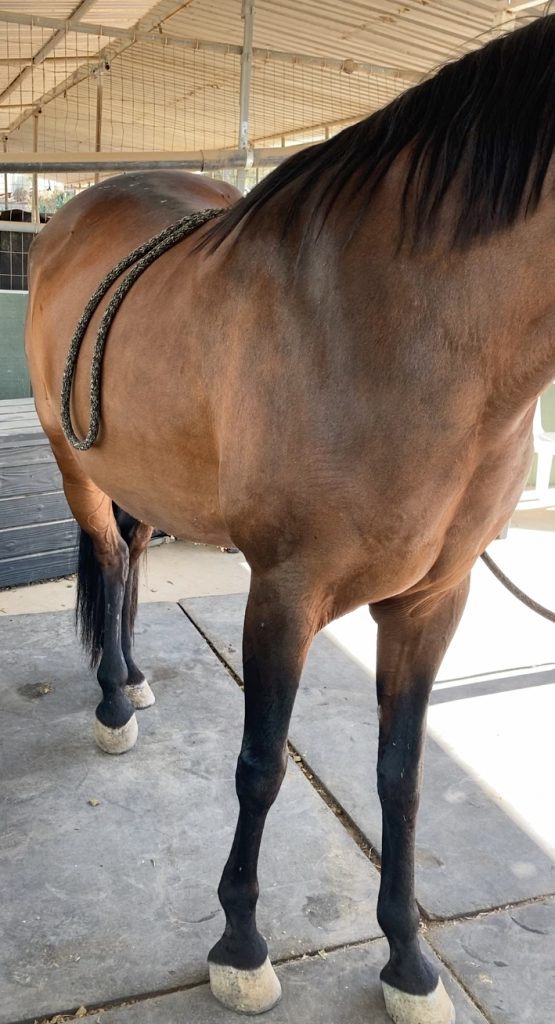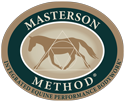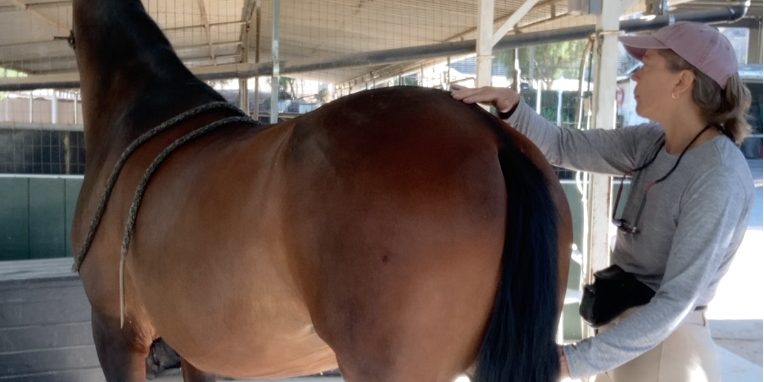When doing The Masterson Method® with a horse, there are three key junctions in the horse’s body, which are our main focus. These are the Poll-Atlas; the Neck-Shoulder-Withers; and the Hind End. Tension on any of these three key junctions can cause excessive tension to accumulate in major muscles and connective tissue. In addition, excessive unilateral (one-sided) use of these muscles will create a unilateral imbalance of tension on these junctions.
In this article, we are going to focus our attention on the sacroiliac joint and one of its main parts, the sacrum. The sacrum is an important anchoring point in the transference of driving forces from the hind limbs to the body. If tension accumulates in the muscles that pull on the sacrum, the sacroiliac joint can become restricted, tight, or “stuck.”
This tension or restriction can have a negative effect on the muscles of the hind end and makes it difficult for those muscles to let go. That’s why using the Hind End Points technique can be a very significant tool to help the horse release tension in that area.
An example of the positive effects of using the Hind End Points is the following case story we received from one of our Masterson Method® Certified Practitioners and Equine Specialist, Amelia Nalli.
Meet Willa

Willa resting her left hind leg during the bodywork
“Willa is an Andalusian Saddlebred cross and I have recently started doing bodywork with her. She is curious and playful but pretty nervous in general. Her owner has been working with her for three years and Willa has gone from a very anxious and scared horse to a sweet and curious partner. The slow and easy groundwork has helped her immensely and when we ride her you don’t need to use any leg, only the slightest shift in weight. I had the feeling that if I asked for too much she was going to hit the road and leave me in the dust.
“What I noticed most about her is that she didn’t relax her hind legs very often so I was hoping to help her by asking for relaxation using the Hind End Points. These are Masterson Method® techniques where we ask for relaxation in the SI Joint, Pelvis, Hip, Under Tail, and Stifle points. Finding responses in these areas along with waiting patiently for a release often takes 20-30 minutes when I really want to focus on hind leg releases. In my mind, a horse should be able to relax the hind legs down often and get relaxation in the deeper muscles of the psoas and entire hind end, to allow for greater mobility and stability of the horse’s engine.
The bodywork session

Willa relaxingly resting her right hind leg
“When I started on the Hip and Pelvis points she was wary and nervous, so I relaxed my fingers and came about an inch off of her hair. She had a small release and then I was able to touch her hair without her getting worried. It took about 15 minutes and I was still on the left side. She had responses along the sacroiliac and then the lumbar area and as I waited on that spot, she closed her eyes.
“I waited for 5 minutes on the same point before she gently let a big breath out and relaxed her hip and took the weight off of the left hind leg. I really wanted to let out a cheer of delight but I just moved on to the stifle and the side of the tail without going under the tail. Her tail wasn’t clamped but she got more nervous when I tried to search for a response on the points under the tail so I just searched for a response next to the tail to keep her relaxed. After about 5 more minutes I removed all the pressure and just let her stand there with her eyes closed in what looked like a deep trance. She let out another breath and relaxed her leg and hip on the right side for another 5 minutes.
“That was the entire session that day and I took her to the round pen for a roll where she even laid down for a bit which is unusual for her. We noticed right away that she wasn’t as nervous in the groundwork and she feels softer and more relaxed when riding with her and in turn, I relax more too.
“As a practitioner there are times when it looks like you aren’t doing anything with a horse, just lightly touching them waiting for the preverbal release. Those are the times when I doubt that this slow, light touch bodywork is really doing anything at all. I have heard Jim and my mentor use the term “doubt the doubt” and it has taken a long time for me to fully understand the meaning of those words. But Willa understands and I’m sure she is very happy that I waited for as long as it took and we have created a deep bond of respect and affection for each other.”
The effects of hind end tension on overall performance
Some of the more visible performance issues that can be the result of excessive tension in the hind end are:
- Lack of impulsion, meaning the horse’s pushing power or thrust is limited.
- Inability to round, step under, or develop “positive” self-carriage. (Flexibility of the lumbar area is the key to this and allows the horse to twist and be able to tilt the pelvis and step under.)
Performance problems become even more obvious when excessive tension develops unilaterally, meaning more to one side than the other. Some signs of this are:
- Refusal to put more weight on a particular hind limb, and resistance to moving on a circle in one direction or the other.
- Inability or unwillingness to canter on a particular lead.
- Refusal or unwillingness to pick up the foot for cleaning or the farrier (ruling out neurological conditions such as stringhalt).
- The horse may appear unsound with no apparent cause.
- He may seem imbalanced or lame
The effects of releasing tension in the sacroiliac joint
So, as described above, the effects of tension on the hind end are important and they should not be ignored or dismissed as bad behavior. Back pain or discomfort is one of the most common complaints horse owners and trainers experience.
When horses become restricted in the sacroiliac junction due to any combination of factors, instead of the forces moving smoothly forward through the body, the brunt of the load is taken by the sacroiliac joint, lumbar spine, and lumbosacral junction. The lower back becomes stressed and painful, the horse compensates for the pain, and a cycle of back pain and negative self-carriage begins.
Once the primary issues that contribute to causing hind-end or back problems are detected and resolved, a Masterson Method® bodywork session can help enormously to get rid of the compensating tension in the hind end, just as Amelia has explained in her experience with Willa.
If we are patient enough to spend the necessary time with the horse using a light touch and wait for them to become aware of the tension, they will eventually be able to release it and start the process of breaking this compensating cycle and therefore feel more supple and comfortable than before.
Some of the text in this article was excerpted from the Beyond Horse Massage book, published by Trafalgar Square Books.
Photos courtesy of Amelia Nalli.
Visit the Masterson Method Store to purchase learning resources such as the Beyond Horse Massage book and DVD or Online Streaming, and visit Masterson Method Courses to find a hands-on Seminar near you.













